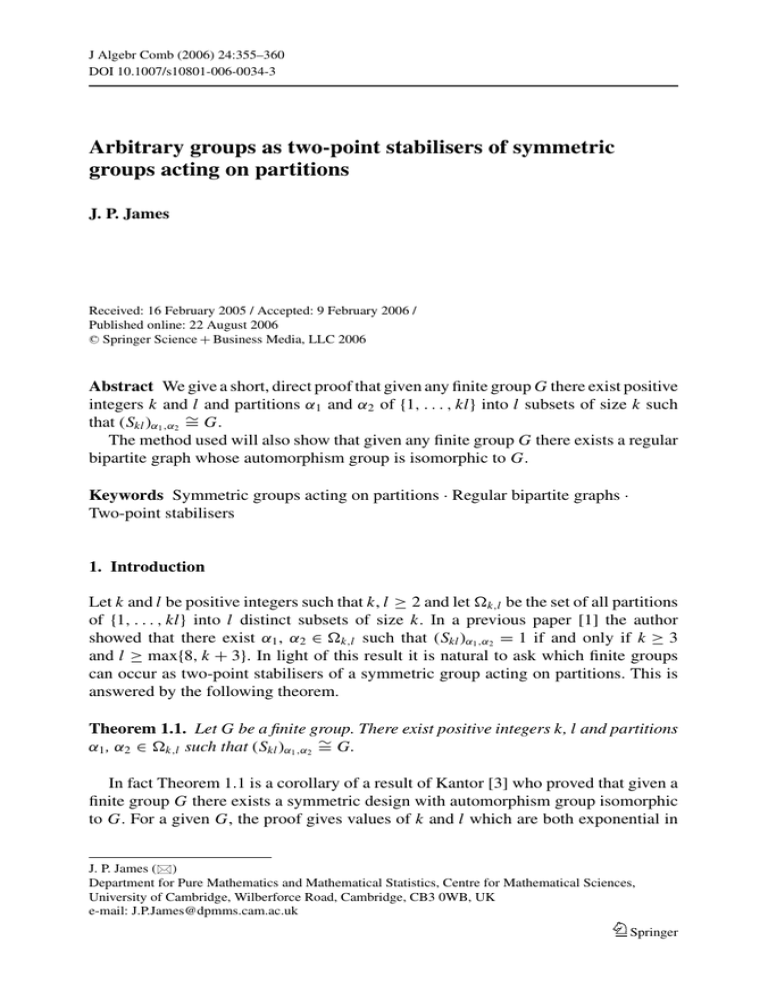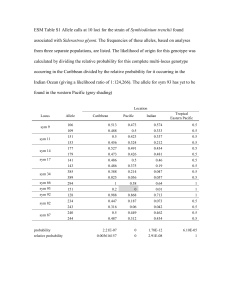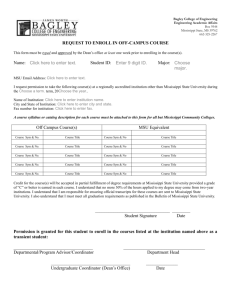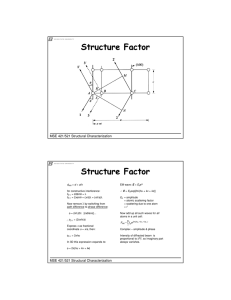Arbitrary groups as two-point stabilisers of symmetric groups acting on partitions
advertisement

J Algebr Comb (2006) 24:355–360
DOI 10.1007/s10801-006-0034-3
Arbitrary groups as two-point stabilisers of symmetric
groups acting on partitions
J. P. James
Received: 16 February 2005 / Accepted: 9 February 2006 /
Published online: 22 August 2006
C Springer Science + Business Media, LLC 2006
Abstract We give a short, direct proof that given any finite group G there exist positive
integers k and l and partitions α1 and α2 of {1, . . . , kl} into l subsets of size k such
that (Skl )α1 ,α2 ∼
= G.
The method used will also show that given any finite group G there exists a regular
bipartite graph whose automorphism group is isomorphic to G.
Keywords Symmetric groups acting on partitions . Regular bipartite graphs .
Two-point stabilisers
1. Introduction
Let k and l be positive integers such that k, l ≥ 2 and let k,l be the set of all partitions
of {1, . . . , kl} into l distinct subsets of size k. In a previous paper [1] the author
showed that there exist α1 , α2 ∈ k,l such that (Skl )α1 ,α2 = 1 if and only if k ≥ 3
and l ≥ max{8, k + 3}. In light of this result it is natural to ask which finite groups
can occur as two-point stabilisers of a symmetric group acting on partitions. This is
answered by the following theorem.
Theorem 1.1. Let G be a finite group. There exist positive integers k, l and partitions
α1 , α2 ∈ k,l such that (Skl )α1 ,α2 ∼
= G.
In fact Theorem 1.1 is a corollary of a result of Kantor [3] who proved that given a
finite group G there exists a symmetric design with automorphism group isomorphic
to G. For a given G, the proof gives values of k and l which are both exponential in
J. P. James ()
Department for Pure Mathematics and Mathematical Statistics, Centre for Mathematical Sciences,
University of Cambridge, Wilberforce Road, Cambridge, CB3 0WB, UK
e-mail: J.P.James@dpmms.cam.ac.uk
Springer
356
J Algebr Comb (2006) 24:355–360
|G|2 . The aim of this paper is to give a simple direct proof of Theorem 1.1 in which
far smaller values of k and l are necessary. We will prove the following result
Theorem 1.2. Let G be a non-trivial finite group. Set k = 4 and l = 2(r + 1)|G|
where r is the minimum number of elements needed to generate G. There exist α1 ,
α2 ∈ k,l such that (Skl )α1 ,α2 ∼
= G.
1.1. Fences
In [1] the author defined fences. We recall the definition (in a slightly more general
form) and the most important result.
Definition 1.3. Let be a finite set and let k be a positive integer such that 2 ≤ k < ||.
A (k, )-fence is a collection of || distinct k-subsets of such that each member
of occurs in precisely k members of .
Remark 1.4. In design theory terminology a (k, )-fence is the blocks of a 1-(||, k, k)
design.
Lemma 1.5. Let be a finite set and set l = ||. Let k be a positive integer such
that 2 ≤ k < l and be a (k, )-fence. There exist partitions α , β ∈ k,l such that
(Skl )α ,β ∼
= Sym() .
Proof: See Lemma 2.3 and Lemma 3.3 in [1].
So to prove Theorem 1.2 it is enough, given G which can be generated by r elements,
to construct a (4, )-fence G , where is a set of size 2(r + 1)|G|, with stabiliser
isomorphic to G.
Remark 1.6. The proof of Lemma 1.5 in [1] shows that given a (k, )-fence we can
construct a k-regular bipartite graph G such that Autb (G) ∼
= Sym() where Autb (G)
is the group of automorphisms of G fixing the bipartite blocks of G. Some more work
shows that there exists a regular bipartite graph such that Aut(G) ∼
= Sym() . See [2]
for details.
2. Cyclic groups
The Main Construction (detailed in Section 3) requires at least two distinct elements
that generate the group. So we deal with cyclic groups separately.
2.1. The group of size two
Set C2 = 1 ∪ 2 where
1 = {{1, 2, 3, 4}, {2, 3, 4, 5}, {3, 4, 5, 6}, {4, 5, 6, 7}, {5, 6, 7, 8}}
2 = {{6, 2, 8, 1}, {2, 8, 1, 7}, {8, 1, 7, 3}}.
Springer
J Algebr Comb (2006) 24:355–360
357
We observe that C2 is a (4, {1, . . . , 8})-fence.
Lemma 2.1. The stabiliser of C2 in S8 has size two.
Proof: Consider a graph KC2 with vertex set C2 in which two sets are joined by
an edge if they intersect in three points. Elements of (S8 )C2 act as automorphisms
of KC2 . The connected components of KC2 are a line of length five and a line of
length three corresponding to 1 and 2 . So if g ∈ (S8 )C2 then g either fixes or
reflects the line corresponding to 1 hence g is either the identity or the involution
(1, 8)(2, 7)(3, 6)(4, 5).
2.2. Other cyclic groups
Let n be an integer such that n ≥ 3. Set Cn = {0, . . . , 4n − 1} and Cn =
where
n−1
i=0
i
i = {{4i, . . . , 4i + 3}, {4i + 1, . . . , 4i + 4}, {4i + 2, . . . , 4i + 5},
{4i + 3, . . . , 4i + 10}}
with addition modulo 4n. We observe that Cn is a (4, Cn )-fence.
Lemma 2.2. The stabiliser of Cn in Sym(Cn ) is isomorphic to Cn .
Proof: As above Sym(Cn )Cn ≤ Aut(KCn ) where KCn is a graph with vertices Cn in
which two sets are joined if they intersect in three points. The connected components
of KCn are n lines of length four corresponding to the sets 0 , . . . , n−1 . So g ∈
Sym(Cn )Cn permutes the sets 0 , . . . , n−1 .
We observe that the permutation σ ∈ Sym(Cn ) given by iσ = i + 4 mod 4n stabilises Cn and sends j to j+1 where j ∈ [0, n − 1] and addition is modulo n.
So Sym(Cn )Cn is transitive on the connected components of KCn and contains a
subgroup isomorphic to Cn . To show that Sym(Cn )Cn ∼
= Cn it is enough to show that
the stabiliser of 0 in (Sym(Cn )Cn ) is trivial.
Let i ∈ [0, n − 1] and suppose g ∈ Sym(Cn )Cn such that i g = i . So g either
fixes or reflects the corresponding connected component. Hence g acts on supp(i ) =
{4i, . . . , 4i + 5} ∪ {4i + 10} either as the identity or the involution (4i, 4i + 10)(4i +
1, 4i + 5)(4i + 2, 4i + 4) where all addition is modulo 4n. We observe that
r the elements 4i and 4i + 1 are only contained in members of i and i−1 ;
r the element 4i + 5 is only contained in members of i and i+1 ;
r the element 4i + 10 is only contained in members of i and i+2
where addition in indices is modulo n and all other addition is modulo 4n. Hence g
can not act as an involution on supp(i ) otherwise it must send i−1 to both i+1
and i+2 simultaneously. Therefore g is the identity on supp(i ) and must stabilise
i+1 . So the stabiliser of 0 in (Sym(Cn )Cn ) is trivial by induction.
Springer
358
J Algebr Comb (2006) 24:355–360
3. The main construction
Let G be a finite group which is not cyclic and r be the minimal number of elements
required to generate G. Since G is not cyclic r ≥ 2. Pick distinct f (1), . . . , f (r ) ∈
G \ {1} such that G = f (i) | 1 ≤ i ≤ r . Set f (0) = f (1).
3.1. Definitions
In order to define a fence G with stabiliser G we require a G-space. Let G 0 ,
0 , G
1 , . . . , G
r be disjoint copies of G and set
G1, . . . , Gr , G
G =
r
i ).
(G i ∪ G
i=0
i ) corresponding
We will write gi (respectively gi ) for the element of G i (respectively G
to g ∈ G. The group G acts on G by right multiplication:
gi h = (gh)i
i
gi h = (gh)
for g, h ∈ G and i ∈ [0, r ]
For each i ∈ [0, r ] we define
Ri = Ri G
with
Ri = {1i , 1i , 1i+1 , 1
i+1 }
Ti = Ti G
with
Ti = {1i , 1i+1 , 1
i+1 , f (i)i+2 }
where all addition is modulo (r + 1). We define
G =
r
(Ri ∪ Ti ).
i=0
and observe that G is a (4, G )-fence and a union of G-orbits, so G ≤ Sym(G )G .
3.2. Intersections
The proofs in the next section rely on the following detailed analysis of intersections
between members of G .
Lemma 3.1. Let g ∈ G and i ∈ [0, r ]. If U ∈ G then
⎧
4
⎪
⎪
⎪
⎪
⎨3
|Ri g ∩ U | = 2
⎪
⎪
1
⎪
⎪
⎩
0
Springer
if U = Ri g
if U = Ti g
if U ∈ {Ti−1 g, Ri+1 g, Ri−1 g}
if U ∈ {Ti−1 f (i − 1)−1 g, Ti+1 g, Ti−2 f (i − 2)−1 g}
otherwise
J Algebr Comb (2006) 24:355–360
⎧
4
⎪
⎪
⎪
⎪
3
⎪
⎪
⎨
2
|Ti g ∩ U | =
1
⎪
⎪
⎪
⎪
⎪
⎪
⎩
0
359
= Ti g
= Ri g
= Ri+1 g
∈ {Ri+1 f (i)g, Ti−1 g, Ti−1 f (i − 1)−1 g,
Ti+1 g, Ti+1 f (i)g, Ri−1 g, Ri+2 f (i)g}
otherwise
if U
if U
if U
if U
Proof:
Each ω ∈ G is contained in exactly 4 members of G and |U | = 4
so
V ∈G |U ∩ V | = 16. Hence
s if there exists a positive integer s and distinct
V1 , . . . , Vs ∈ G such that i=1
|U ∩ Vi | = 16 then U ∩ V = ∅ for all V ∈ G \
{V1 , . . . , Vs }.
Corollary 3.2. Let g ∈ G and i ∈ [0, r ]. If h ∈ Sym(G )G then there exist g ∈ G
and an integer i such that 0 ≤ i ≤ r and (Ri g)h = Ri g .
Proof: By Lemma 3.1, if k ∈ G and j ∈ [0, r ] then exactly three members of G
intersect R j k in two points whereas only one member of G intersects T j k in two
points.
Corollary 3.3. Let g, g ∈ G and i, i ∈ [0, r ].
1. If h ∈ Sym(G )G such that (Ri g)h = Ri g then (Ti g)h = Ti g .
2. If h ∈ Sym(G )G such that (Ti g)h = Ti g then (Ri+1 g)h = Ri +1 g .
Proof: By Lemma 3.1, if k ∈ G and j ∈ [0, r ] then T j k is the unique member of G
which shares exactly three points with R j k and R j+1 k is the unique member of G
which shares two points with T j k.
3.3. The proof
We set S = {Ri , Ti | 0 ≤ i ≤ r } and observe that SG is a partition of G into |G| sets
of size 2(r + 1).
Lemma 3.4. Let g ∈ G. If h ∈ Sym(G )G then there exist an integer j and g ∈ G
such that (Ri g)h = Ri+ j g and (Ti g)h = Ti+ j g for all integers i ∈ [0, r ]. In particular, if h ∈ Sym(G )G then there exists g ∈ G such that (Sg)h = Sg .
Proof: Corollary 3.2 shows that there exists an integer j and g ∈ G such that
(R0 g)h = R j g . The rest follows by induction using Corollary 3.3.
Lemma 3.5. Let g ∈ G. If h ∈ Sym(G )G such that (Sg)h = Sg then
1. (Ri g)h = Ri g;
2. (Ti g)h = Ti g;
3. (S( f (i)g))h = S( f (i)g)
for all i ∈ [0, r ].
Springer
360
J Algebr Comb (2006) 24:355–360
Proof: By Lemma 3.4 there exists an integer j such that (Ri g)h = Ri+ j g and
(Ti g)h = Ti+ j g for all integers i ∈ [0, r ]. The element ( f (s)g)s+2 is the unique member of Ts g \ Rs g for all s ∈ [0, r ] so ( f (i)g)i+2 h = ( f (i + j)g)i+ j+2 for all i such
that 0 ≤ i ≤ r . Given s such that 0 ≤ s ≤ r the three members of G \ {Ts g} which
contain ( f (s)g)s+2 are all contained in S( f (s)g) hence (S( f (i)g))h = S( f (i + j)g)
by Lemma 3.4. So
S( f ( j)g) = (S( f (0)g))h = (S( f (1)g))h = S( f ( j + 1)g),
therefore j = 0.
Lemma 3.6. Let g ∈ G and i ∈ [0, r ]. The element gi is the unique member of Ri g ∩
Ti−2 f (i − 2)−1 g and gi is the unique member of Ti−1 g ∩ Ti g.
Theorem 3.7. Sym(G )G ∼
= G.
Proof: By Lemma 3.4 the orbit of S under Sym(G )G is the same as the orbit under
G. Hence
|Sym(G )G | = |G| · |(Sym(G )G )S |
and since G ≤ Sym(G )G it is enough to show that (Sym(G )G )S = 1.
Let h ∈ Sym(G )G such that Sh = S. For g ∈ G we will write |g| for the length
of the shortest word in { f (1), . . . , f (r )} which is equal to g. Induction on |g| using
Lemma 3.5 shows that (Sg)h = Sg for all g ∈ G. Hence U h = U for all U ∈ G
by Lemma 3.5. So ωh = ω for all ω ∈ G since there exists V , W ∈ G such that
V ∩ W = {ω} by Lemma 3.6.
Theorem 3.7 completes the proof of Theorem 1.2.
Remark 3.8. The stabilser of the partitions αG , βG ∈ k,l constructed from G by
Lemma 1.5 can be shown to lie in Akl . Hence (Akl )αG ,βG ∼
= G. See [2] for details.
Acknowledgment The author would like to thank the Engineering and Physical Sciences Research Council
for providing financial support. He would also like to thank his supervisor Professor Jan Saxl and a referee
for their comments which have substantially improved this paper.
References
1. J.P. James, “Partition actions of symmetric groups and regular bipartite graphs,” Bulletin of the London
Mathematical Society 38 (2006), 224-232.
2. J.P. James, PhD thesis, The University of Cambridge, (2006). In preparation.
3. W.M. Kantor, “Automorphisms and isomorphisms of symmetric and affine designs,” Journal of Algebraic
Combinatorics 3 (1994), 307–338.
Springer








